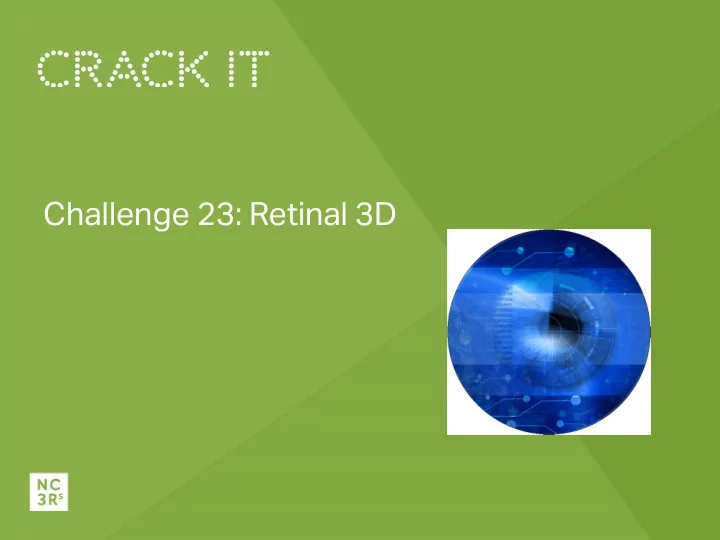

Challenge 23: Retinal 3D
Retinal 3D: A Physiologically-Competent Human Retinal 3D Model Launch Meeting 08 September 2016 Stefan Kustermann (Roche), Phil Hewitt (Merck), Francois Pognan (Novartis) or Marianne Uteng (Novartis) (who will be present at the meeting)
The Challenge Establish a human 3D retinal cell model: Physiologically-competent and predictive of human physiology Consist of all major cell types of the retina : Müller- and micro-glia, RPE and neurons (including photoreceptors) Enable cellular interplay Recapitulates key morphological and functional features Provide a panel of relevant readouts for functional testing
Why was this Challenge developed? Scientific – Business - 3Rs drivers Over 60 million people worldwide are blind Leading causes of blindness in the industrial world is AMD Globally, in ophthalmology, more than 600 R&D projects running – with more to come Large scientific and business impact of a novel human 3D retina model Current in vitro models have major limitations: cells are immature, no interplay between different cell types, functionality limited, lack human relevance etc. strong need for better models of human relevance majority of studies for efficacy and safety testing in ophthalmological drug development are performed in animals due to lack of relevant in vitro models Ocular safety studies in vivo use up to 20 animals per compound strong impact on 3Rs if human relevant model can be applied for R&D
Current state of the art Single cells: 2D cell line models (human and rodent): ARPE19, Mio-M1, 661W etc. Complex models: Retinal explants of mouse, rat and pig Stem cell derived models: retina 3D spheroids and isolated cells thereof Lack of a human relevant , complex retinal 3D model
Established complex retinal cell models: Retinal explant cultures remains viable as an explant in serum-supplemented growth media for more than 4 weeks histotypic development of neonatal as well as preservation of late postnatal mouse retinal structure during long-term culture also feasible with: Rat (Pinzon-Duarte et al 2000) Pig (Wang et al 2011) Zebrafish (Kustermann et al 2008) Not feasible with human retina due to lack of tissue e.g. Caffé et al. 2001
Established complex retinal cell models: Whole embryonic-body culture Mouse ES cells generate fully stratified neuro-retinas after 24 days Photoreceptors can be isolated and transplanted into eyes in vivo and morphologically integrate Phenotype of cells is pre- mature and long differentiation time for e.g. photoreceptors and glia cells (humans ~6 month) e.g. Eiraku et al. 2011; Gonzalez-Cordero et al. 2013
Deliverables Phase 1 Mimic ic the e morphol rphology ogy and d physio siology ogy of the e mature ure huma man n retin tina: Morphological resemblance of layered structure of the retina • i.e. plexiform and nuclear layers Sustained expression of cell specific (mature) markers by IHC • of all implemented cell types Basic functional characterization: e.g. synapse formation • between neurons by IHC, tight junction expression between RPE cells, phagocytotic activity of microglial cells
What we don’t want A model that requires complex and time consuming set-up, impeding parallel testing of multiple conditions Incorporate only cytotoxicity as a readout Incorporate material which is known to show strong compound adsorption (e.g. PDMS) Require specific legal work for acquisition of source cells and materials (i.e. individual informed consent for each study/experiment)
Deliverables Phase 2 “Must have” Thorough functional and morphological characterisation of the retinal model including recapitulation of drug induced retinal toxicities: Development of additional methods to address function and/or phenotypic changes of the different cell types in culture Provision of accessible morphological and functional readouts and be compatible with standard microscopes Recapitulation of retinal toxicities of known drugs (e.g. Chloroquine, …) Amenity to the testing of compounds in parallel (multi-well-plate setting) Easy to implement in an industry laboratory setting, reproducible and easily transferrable between laboratories Assessment of inter/intra-laboratory reproducibility Adaptability to other species relevant for safety assessment (rodent and /or non- rodent) Evidence of cost efficiency and applicability to individual and longer term experiments
Deliverables Phase 2 “nice to have” Demonstration of the barrier function of outer and/or inner-limiting membrane A functional blood-retina barrier Vasculature (endothelial cells) to mimic neo-vascularization and leakage of blood vessels to model disease phenotypes such as Diabetic Macular Edema Clear strategy how to commercialise the results into a product or service
Sponsors’ contributions Expertise in ophthalmology and in vitro models including specifications for an in vitro model which is fit for purpose for drug testing in an industry setting Compounds and knowledge of compounds where available for evaluation of both the pharmacological and toxicological performance of the in vitro retinal test system Potential for in-house testing using the system to test transferability and reproducibility of the 3D retinal in vitro model
Thank You The Sponsors are happy to discuss the challenge and potential applications with people in the run up to the submission deadline Sponsor contacts are: Roche Dr Stefan Kusterman stefan.kustermann@roche.com Merck Dr Philip Hewitt Philip.Hewitt@merckgroup.com Novartis Dr Francois Pognan francois.pognan@novartis.com Dr Marianne Uteng marianne.uteng@novartis.com Bayer Dr Thomas Steger-Hartmann thomas.steger-hartmann@bayer.com NC3Rs crackitenquiries@nc3rs.org.uk
Recommend
More recommend